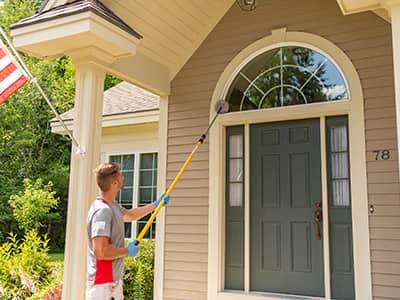February 10, 2023
Should mice infest your basement or garage, chances are you’ll notice them quickly. After all, most Mainers utilize both spaces and visit them with regularity if not daily. That is not the case with the attics though. While perfect for holding seasonal decorations and other odds and ends that you have no intention of using any time soon, they don’t often receive the same foot traffic as the other spaces. That makes attics the perfect place for mice.

Why mice are attracted to attics
During the winter months, mice are attracted to any space that provides warm shelter and that is near to food. In a home with multiple levels, that could be anywhere from the basement to the attic; it could also be someplace in between (read What To Do About Mice In The Walls). Attics are ideal for all types of rodents in Maine as well as other pests because they’re relatively undisturbed (meaning not much foot traffic), the cold and winter elements can’t reach them under the roof, and the attic isn’t that far from the kitchen. Did we mention, there’s plenty for them to chew on to keep their incisors short and a plethora of nesting materials available? Electrical wires make great chew toys and attic insulation and cardboard boxes are just a couple of great options for padding nests.
How mice get into attics
The truth is rodents can access attics quite easily. All they need is an entry point big enough for their bodies to slip through. Unfortunately, these contortionists can squeeze through openings ¼ of an inch or larger.
While cracks, gaps, and other openings on the ground level are easy marks for opportunistic mice, these rodents will use tree branches that touch upper levels of houses to reach the roofline and they’re also adept at climbing. It really wouldn’t take much effort on their part to climb up the side of your house or even use your downspouts to reach higher levels.
3 signs of mice in the attic
If you’re worried that mice have infested your attic but haven’t actually seen live rodents, look for the following signs of mouse activity:
#1 Hearing scratching noises and movement
Mice are primarily nocturnal creatures that move around under the cover of darkness. This is why homeowners often hear scratching noises and scurrying sounds overhead or in the walls at night.
#2 Finding droppings
Since mice aren’t particularly picky about where they go #1 or #2, droppings and urine stains are often discovered wherever these pests are infesting. Mouse droppings look like dark grains of rice with tapered ends. They are approximately an eighth to a quarter of an inch in length. If you’re seeing droppings larger than that, you might be dealing with rats or some kind of wildlife.
#3 Nesting materials
Not prone to let an opportunity slip by them, mice will use just about anything they can tear, shred, or abscond with to make their nests. Common nesting materials include cardboard, paper, attic insulation, clothing as well as other fibrous material.
If you have mice in the attic, there will be damage if you don’t address the infestation
Mice are truly some of the worst houseguests you could have. As we’ve already established, they will go to the bathroom wherever they want and raid your kitchen for sustenance. They’ll also inflict damage to your home and belongings if you don’t take action at the first sign of a mouse problem. In the attic, mice will:
- Weaken the wood that is keeping your home structurally sound by incessant chewing
- Destroy drywall, attic insulation, and other building materials
- Chew on wires, creating fire hazards
- Contaminate insulation and stored items with their droppings
- Damage or destroy belongings
Mice also introduce health risks
Even if a mouse infestation is contained to an attic (which probably won’t be the case), there’s a very good chance that the bacteria and germs they introduce on their bodies could become a health issue for the household.
How to keep mice out of the attic
If you want a mouse-free attic and home, you must be diligent in sealing every single hole and opening on the outside of your home that would give mice access.
What to do if your attic has become a hotspot for mouse activity
If you’re concerned that your attic has been taken over by mice or other pests, Pine State Pest Solutions is ready to help!
Providing effective rodent control services in Lewiston, Auburn, and Portland as well as throughout our multi-county service area for 10+ years, our locally owned and operated pest control company will develop a customized plan that could include:
- An initial rodent clean-out
- Minor exclusion work
- Installation of bait boxes to prevent mice from re-infesting
- Follow-up services as needed
We’ll also identify conditions that are attracting mice to your home and offer suggestions on how to make your property less appealing to these nuisance and destructive pests.
We also offer home pest control plans for rodents and insects
In addition to our one-time rodent control services, we also offer home pest control services that provide year-round protection against mice and other common house-infesting pests including ants and spiders.
Home Protection Plan
Starting as low as $35/month*

Pine State’s Home Protection is an affordable pest control plan that is ideal for homeowners who want general pest control services that target common house-infesting insects and rodents.
When you sign up for this ongoing service, you’ll receive an initial service visit to treat the existing pest problem and then seasonal service visits spread out over the year to ensure pests stay out. That’s a total of four services annually.
Pests covered under Pine State’s Home Protection plan include carpenter ants, cornfield ants, crazy ants, field ants, little black ants, pavement ants, carpet beetles, cigarette beetles, drugstore beetles, flour beetles, ground beetles, hide beetles, larder beetles, saw-toothed grain beetles, warehouse beetles, boxelder bugs, carpenter bees, centipedes, clover mites, American cockroaches, brown-banded cockroaches, wood cockroaches, field crickets, house crickets, European earwigs, firebrats, bald-faced hornets, European hornets, deer mice, house mice, millipedes, Angoumois grain moths, drain moths, Indian meal moths, Mediterranean flour moths, mud daubers, Norway rats, paper wasps, pill bugs, rice weevils, silverfish, sow bugs, springtails, cellar spiders, daddy longlegs spiders, house spiders, jumping spiders, sac spiders, wolf spiders, Western conifer seed bugs, and yellow jackets.

 Subscribe
Subscribe